
Photographic Anthropological Portraits
in British Scientific Journals, 1860-1930
- Valérie Morisson
_______________________________
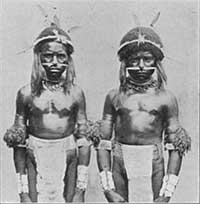
Fig. 6. Orokolo Men, JAIGBI, 1902 
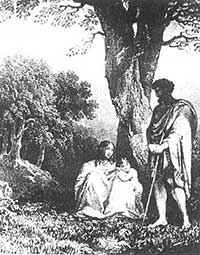
Fig. 8. “Toda group, Nilgiri Hills”, 1832 
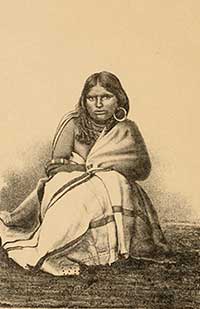
Fig. 9. “Toda Woman”, Journal of
Anthropology, 1870 
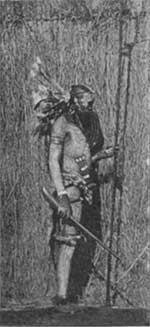
Fig. 10. Youth Painted for the
“Irua”, JAIGBI, 1904 

Fig. 11. The king of Fakaofu wearing
the emblem of royalty, JAIGBI, 1892 
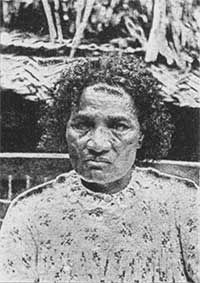
In the early 20th century, natural poses were increasing preferred to stiff stances. The portraits illustrating an article on the Kavirondo and the Nanadi [69], enhance the body ornaments and costumes but show young women (Jaluo Girl, Kajulu Tribe, or Lumbwa Woman) in fairly natural poses. Even though the sitters are still identified by their ethnic types rather than by their individual names, there is some liveliness in these portraits. In the same way, the photographs printed in a 1907 article, “The Bahima: A Cow Tribe of Enkole in the Uganda Protectorate,” suggest some intimacy and confidence between the photographer and the people. The sitters are smiling and cast friendly looks at the photographers.
A large number of photographs in the Review document costumes, body ornaments, properties, and customs or traditions. Material culture was known through a spate of illustrations printed in books of all sorts, the indexical nature of photographs being considered perfectly suitable for the rendering of artefacts [70]. Both Alfred Cort Haddon [71] and Im Thurn agreed that presenting objects in context was of great interest.
Accordingly, artefacts are foregrounded in some photographs even though outline drawings of handicrafts are preferred to photographs, which offer too many details. Photographs may nonetheless have an explanatory function, as is the case in “Note on the Preparation and Use of the Kenyah Dart-Poison Ipoh,” [72] illustrated by a series of photographs on the making of a poisoned arrow. In this context, both drawings and photographs derive their meanings from the elaboration of a series, their ordering and the addition of explanatory captions.
In the case of costumes, which are often so richly decorated that they may be difficult to draw, photographs are preferred. The photograph signed L. H. L. Huddart, Esq. printed in “Notes on the Asaba People (Ibos) of the Niger” [73] clarifies the complex textual description: “the distinguishing mark is a circle of broom (termed Aziza, from the palm tree), knotted before and behind, with upturned ends a couple of inches or so in length.” The face of the chief is partly hidden by the azuzu, “a circular fan made of untanned cow-hide, usually ornamented with red cloth strips or some similar decoration, and a short thin handle.” In many portraits, the rigid stances, the inexpressive, shy or hostile gazes of the costumed sitters betray their reluctance to be photographed in garments that are worn only on special occasions. For want of visual contextualization, the sitters may be turned into objects of curiosity and fail to hide their discontent (fig. 6 [74]). The captions, describing only the dress, may heighten the disindividualization at work in the photograph. They may also, in some cases, draw our attention towards an object which does not occupy a central place in the image, suggesting that the photograph was not originally meant to accompany the text [75].
As Joanna C. Scherer explains, “the visual in Western culture is often associated with intuition, art and implicit knowledge, while the verbal is associated with reason, fact, and objective information.” [76] Implicit information may be conveyed by the background. Artistic as well as pseudo-anthropological portraits often integrate the characters into landscapes which offer a counterpoint to industrialized European cityscapes. In studio portraits, backdrops imitating Western landscape painting were commonly used satisfying “the Victorian taste for escapism and possessions.” [77] J.W. Lindt’s photographs of Australian aborigines display stereotypical backgrounds which are prime examples of European primitivism [78]. Anthropological photographs could be shot in similar settings [79]. Commercial ethnological photography could borrow from genre scenes or orientalist painting, and be included in an anthropological volume, as is the case in William Johnson and William Henderson’s studio portraits [80]. Their scenes featuring traditional objects are imbued with exoticism and Orientalist sensitivity.
In fact, very few illustrations in the Journal are aestheticized. Published in the Journal in 1902 to illustrate an article on the ethnography of the Nagas, the portrait of a “Headman of Naogong in War Costume” shows the figure against a background that resembles painted backdrops (fig. 7  ). The landscape hardly gives the readers any clue as to the circumstances in which the costume is worn, or the number and social origin of the warriors [81].
). The landscape hardly gives the readers any clue as to the circumstances in which the costume is worn, or the number and social origin of the warriors [81].
In the full-length portraits published in the Review, the characters are often shot against a neutral background which enhances ethnographic details. A comparison between two drawings of the Nilgiri Hills people, but produced for different publications (figs 8 and 9), reveals that contrary to the frontispiece of the travel book, which borrows from pastoral landscape painting, the plate illustrating Major W. Ross’s paper on “The Aboriginal Tribes of the Nilgiri Hills” [82] neutralizes the setting. The isolated figure, the plain background, and the even lighting are distinctive modes of representation [83]. The framing of photographs also focuses on the figures rather than on their surroundings to facilitate ethnological observation. The photographic portraits illustrating H.R. Tate’s “Notes on the Kikuyu Tribe of East Africa” are shot against neutral backgrounds, to evidence that “As young unmarried youths are looking out for their future wives at this time, a good deal depends upon the effect of their toilet at these dances, which are called Rua. It is at these dances that the ndomi or shoulder shield is worn, as shown by the accompanying photograph” (fig. 10) [84]. The absence of visual contextualization is counter-balanced by minute textual descriptions.
In most portraits, the absence of spatial or temporal context heightens the allegorical and allochronic value of the representation as identified by Fabian: “photographs become symbolic structures, reifying culturally-formed images as observed realities.” [85]
New Framings, New Approaches
Visual conventions gradually evolved towards greater individualization and contextualization. These changes in the framing of the scenes reflected theoretical shifts. In the Journal, few individualized portraits leave room for psychological individualization: even when the sitters are photographed in natural poses and when their faces, in close-up, are stamped with emotions, the caption dictates another reading by focusing on the social status or the costume of the sitters. The portraits illustrating an article on the natives of Fakaofu (Bowditch Island) [86] are an exception. One of them is identified as “The King of Fakaofu wearing the emblem of royalty”; another portrays “The Queen of Fakaofu in full face” (figs 11 and 12). Yet the other tribe members portrayed are simply identified with designations such as “a woman of Fakaofu.”
[69] C. W. Hobley, “British East Africa: Anthropological Studies in Kavirondo and Nandi”, JAIGBI, vol. 33, 1903, pp. 325-359.
[70] Edwards, 2001, Op. cit., pp. 54-55: “the photograph functioned as an imprint of object operating in a rhetoric of transparency and truth”.
[71] “Photography and Folklore”, Folklore, 6, 1895, pp. 222-4.
[72] C. G. Seligmann, JAIGBI, vol. 32, 1902, p. 242.
[73] John Parkinson, JAIGBI, vol. 36, 1906, p. 315.
[74] Orokolo Men. Rev. J. Holmes, “Notes on the Religious Ideas of the Elema Tribe of the Papuan Gulf”, JAIGBI, vol. 32, 1902, pp. 418-425.
[75] In H. R. Tate’s “Notes on the Kikuyu Tribe of East Africa” (JAIGBI, vol. 34, 1904, pp. 255-265) one of the plates (a photograph signed R. Meineitzhagen) features a man squatting on the ground. The caption, “Kikuyu Finger Rings” incites the readers to focus on a detail in the photograph.
[76] “The Photographic Document: Photographs as Primary Data in Anthropological Enquiry” in Edwards, Op. cit., 1994, pp. 32-41, p. 32.
[77] Ibid, p. 204.
[78] In the 1880s and 1890s, many locally-established professional photographers, like Julius E. Muller, who had an open-air studio in Suriname, made many full-length portraits of indigenous population using painted backdrops.
[79] In the 1870s, Carl Dammann, who had been commissioned to do a series of anthropological photographs by the Berliner Gesellschaft für Anthropologie, photographed people from Amazonia in stereotypical settings. His album, published in Germany and England in 1874, Anthropologisch-Ethnologisches Album von C. Dammann in Hamburg, enjoyed a wide success among the public but elicited less enthusiasm among Parisian scientists (see an example on the site of the Expositions de la Bibliothèque nationale de France).
[80] Their photographs, taken in Bombay for The Indian Amateur’s Photographic Album (1856-1859), were subsequently integrated into one of the earliest anthropological works making direct use of photography. See Johnson & Henderson, BnF, département des Cartes et Plans, Société de géographie, Sg Wd 279 (44). Hight and Sampson, Op. cit., p. 58.
[81] In an 1875 article by T. G. B. Llyod, “On the Beothucs” (JAIGBI, vol. 4, 1875, pp. 21-39), a tribe of Indians is represented in a canoe. The image can be likened to some paintings of the American West.
[82] Anthropological Review, Art II, by Major W. Ross King, Journal of Anthropology, ed. John Beddoe, 1870-1871, London, Longmans, Green, and Co, pp. 18-51, n°1 July 1870.
[83] Edwards, Op. cit., 2001, p. 143.
[84] JAIGBI, vol. 34, 1904, pp. 255-265.
[85] Fabian, 1983, p. 117, in Edwards 2001, Op. cit., p. 8.
[86] JAIGBI, vol. 21, 1892, pp. 43-63.


